One of the most interesting tarot things I’ve learned in the last month is how the majors were not originally numbered.
(That link includes the typical list, 22 cards numbered from 0-21.)
~ ~ ~
In her book Tarot 101, Kim Huggens suggests an exercise where you re-order of the majors according to a story structure
The commonly suggested “story” of The Fool’s Journey has never worked for me as much of a story, so I loved the idea.
I took this on because she suggested a form of The Hero’s Journey – something I already have familiarity with – so it felt like a solid foundation to build on.
That link is to a version of the Hero’s Journey I wrote about some years ago. If you like to write fiction you’ll find a whole new rabbit hole to explore in that series.
What I’ve laid out here is the order I came up with based on the way I see the majors and how they line up with the pattern (Departure, Initiation, Return) as Huggens laid it out in her book.
Departure
1. Call to Adventure

Wheel of Fortune. The randomness of fate – often proving to be not-random (destiny).
I love the sphinx in this card for this position, and she’s surrounded by the elements: Earth, air, fire and water. You know from go this isn’t a game, and everything is involved, whether for you or against you.
2. Refusal of the Call
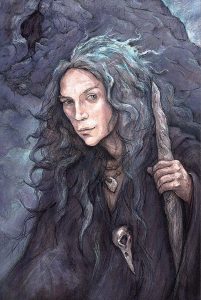
The Hermit. No desire to engage. Alternatively, the hero might already be fully engaged in their current/inner world and aren’t responsive to or motivated by the call when it first appears.
After all, how many of us would respond to an outrageous demand from a stranger.
And these demands almost always seem outrageous…
3. Supernatural Aid

The Magician. Here we add to that story all the raw material (resources) and power.
This is the point where the hero is convinced that what needs to happen is mathematically possible: those elements mentioned in The Call? Here with the magician we see the physical representation of each of them as tools: The wand for fire, sword for air, cup for water and the pentacle for earth.
4. Crossing the First Threshold

This is the fight our protagonist has to be able to enter the arena. The big change embraced, even as they don’t fully know all they’re saying yes to. Of course I saw The Fool.
I love how she’s got her little knapsack and her dog. She doesn’t have to have everything figured out before she starts, but she doesn’t have to be alone or empty-handed, either.
5. The Belly of the Whale

The worst so-far – and we’re not all that far in yet. This is a form of rebirth through a death-like experience. The Empress: the power of life and death, tied up in nurture (or the withholding of it).
This is sometimes where our hero realized the stakes – how much there is to lose, which restated can also be a reminder of how much there is to fight for.
Initiation
1. Road of Trials

Being tested and prepared for worthiness:

The Hierophant and The Devil. These two are both about control – internal and external – and how we make choices, or have them made for us. Ultimately they are explorations of the will and how it interacts with desire and expectations.
What I found so interesting about this combination is that there is not a clear good-guy/bad-guy dichotomy here. They each have gifts and burdens they bring with them.
2. Meeting with the Goddess

Cooperation with and understanding of what protagonist lacks – whether that is divinity, symbolic mirroring (“completion”) through opposite gender – assuming the hero is male – or acknowledging some other deficit, like knowledge. This is a moment of humility and connection. The High Priestess.
We don’t know what we don’t know, but we know we don’t have it all together and open to that rather than hide it.
3. Temptation by a False Path

The Moon. Coming as it does right after the meeting with the goddess, I see this as too quickly releasing the humility of learning, and acting as though one can see clearly. The Moon may be a deceiver, or it may just be itself and not enough illumination to provide all the detail for a fully-informed choice.
It can also represent seasons and cycles (think of the waxing and waning of the moon), and in that represent a temptation or tendency to fall into old patterns of behavior.
4. Atonement
Reconciling the warring aspects of the self – shown, perhaps, by the false path.


The Lovers and Justice. The Lovers here are about harmony, and an inevitability of coming together, of choosing the strength of solidarity between differences. Justice is about balance and clear-sight – in this case of the self in the midst of folly and reining that self back in to the constraints of honor.
This can be about accountability – both to the self (what kind of person do you want to be?) and to a power or understanding larger or outside of one’s self.
5. Apotheosis

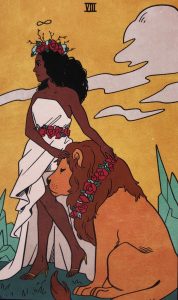
A word that means becoming godlike. This is the rite of passage or moment in the story where the Ego is destroyed, paving the way to a new and higher consciousness: The Tower and Strength.
Here we have the breaking down and breaking away of everything that doesn’t serve (Tower) and coming alongside or right behind is the means of rebuilding.
6. The Ultimate Boon
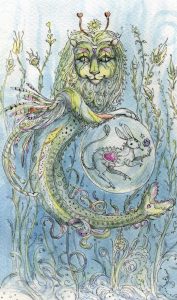
The hero’s reward. What they set out to achieve. The World.
I really like this placement of The World, since so much of its meaning is wrapped up in end-not-end. It makes more sense to me here in a middle-ish where it might tempt one to just be done now.
Which is what happens to our hero at the very next [should be] turning point.
Return
1. Refusal of Return

Things are so good, I have what I want, why go anywhere?
Or. Rock bottom: I have no reason to go on, no energy to endure more.
Lethargy. Disengagement: The Hanged Man.
This is different from the Hermit earlier, because that person had goals – just not aligned with – in cooperation with – the quest yet.
This person is content to not-move, but as long as we’re not-moving the story doesn’t go on.
2. The Magic Flight

What gets you home “whether you will or no.” The Chariot: A combination of your will and something greater.
The Chariot is so much about will, drive and power. It can be what made the hero move (dragging them along) or the part inside them that motivated them anew.
3. Rescue From Without
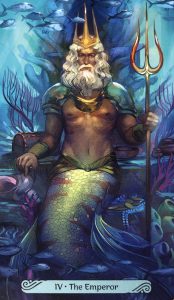
Hero may need to be rescued by some power from his old world. Here I see The Emperor. The established order joining its power to this goal.
That great story-moment when the powerful steps up/steps in to close the gap – ideally without lording-over or trying to dominate/take over.
Obviously not every story has every step, but I’ll say this is one of my favorite: it can sometimes be played as a reconciliation and/or a blessing, where the-powers-that-be work alongside the new power that is this growing hero, and see the newcomer in the fullness of who they are – sometimes for the first time.
4. Crossing the Return Threshold
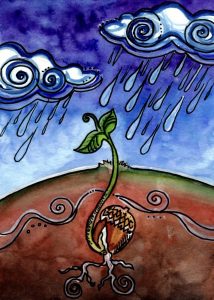
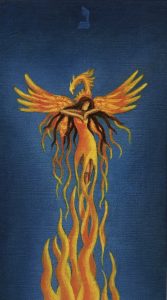
Going back where you came from, accepting the old reality as real and normal: Judgement and Death.
There is inevitability, clarity, loss, change, and a cycle that returns.
These are non-traditional images for these cards, but they fit so well here. Death as a phoenix reborn speaks to the transforming and energetic power of the death card – the end of the the way things are, the known, change.
Similarly, Judgement as a seed sprouting speaks to the necessity of the burial, and the “true self” being revealed through the dirt and the storm.
Both of these images and concepts come to the fore when returning to the old world – the place where our hero began – irreversibly changed.
5. Master of Two Worlds


Through the power of the Boon (The World at the end of Initiation above), our hero can now perceive and live in both the mundane and magical worlds. This is Temperance, truly, and also the Sun – for energy, enthusiasm & delight.
This isn’t a mere consolation prize, it’s an accomplishment.
It can legit be a lot of work – the figure in temperance seems constantly to be in motion, seeking balance – but the light of the sun is energizing and providing the clarity to keep on.
6. Freedom to Live

Hero can now share the boon with the wider world. The Star – clarifying, light, healing, freedom, direction.
“Just living is not enough,” said the butterfly, “one must have sunshine, freedom, and a little flower.”
– Hans Christian Anderson
~ ~ ~
If you are a story person, I highly recommend taking the time to explore your favorite story formats in connection to the tarot. This exercise was extremely beneficial for me.
There will always be cards you feel a closer affinity to, or understand with a deeper complexity, but/and tying all of the majors to a story format added depth and links between cards that I had not experienced before. I’m still thinking about this exercise.
P.S. to anyone who wants to try this for themselves – it was an unplanned bonus for me to have worked this with a deck that doesn’t number its majors. Look for an unnumbered set of majors to use if you have one – the power of this practice is in making your own connections and owning what the majors mean to you when you read.
Cheers!
